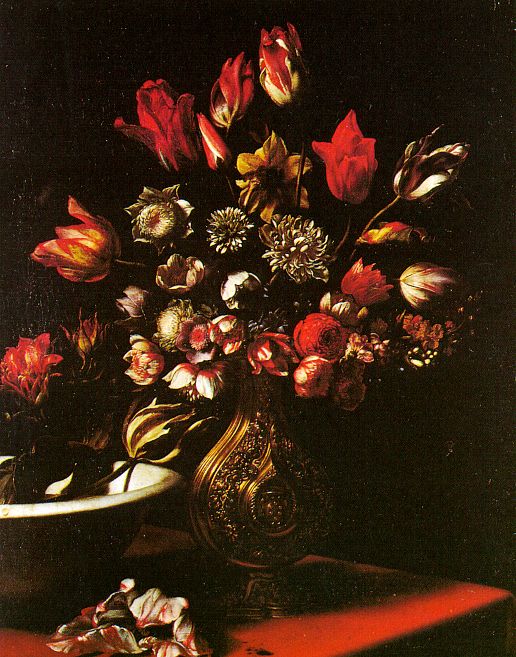By: Amy Fredrickson
Painter Carlo Dolci was born on 25 May 1616 in his native Florence. Baldinucci included ‘Notizie di Carlo Dolci’ in his publication Notizie de’ professori del disegno, and he presents the artist and close friend, with the utmost praise, emphasising that he was the rebirth of ‘diligenza practica paziente’ due to his pious and perfectionist nature and his meticulous attention to draftsmanship. Referencing his short stature, Baldinucci affectionally called him ‘Carlino,’ meaning ‘little Carlo.’
In 1625, at the age of nine, he undertook an apprenticeship in Jacopo Vignali’s workshop. He developed the ability to depict intense subjects while working closely with Vignali. Archival documents show that at the age of 16, in 1632, Dolci was supervising his own workshop. When other Florentine artists relocated to Rome, the center of Baroque painting, Dolci stayed in Tuscany and developed his style from traditional Florentine painting.
Don Lorenzo de’ Medici noticed Dolci’s talent and employed the young artist. While working for the Medici court, he also held the patronage of Grand Duchess Vittoria delle Rovere, who was a fervent patron of the arts. Dolci was known for his piety during his lifetime. His works are typically highly emotional and meticulous depictions of religious subjects. In fact, he wrote that it was his “firm intention to paint only works that would inspire the fruits of Christian piety in those who saw them,” further emphasizing his religious fervor.
By the 1640s, Dolci’s work was in such high demand in Florence that he executed copies of his own work. His daughter Agnese Baci (1559-1731) also painted in his workshop, although her works are difficult to attribute. Dolci’s paintings showcase his ability to illuminate his subjects with radiant pallet choices, vibrant colours, and an enamel-like finish. Dolci worked slowly and meticulously. Many of his works are smaller commissions depicting half-length single subjects, which showcase an intense religiosity while also portraying his sophisticated style. He rarely undertook altarpieces.
Dolci’s style differed remarkably from other contemporary painters, especially that of fellow Medici Court painter and rival Luca Giordano (1634-1705). Giordano was nicknamed “fa presto” because he could paint more in five hours than Dolci finished in months. Regarding Dolci’s slow working method Baldinucci wrote that “Sometimes he would take weeks over a single foot.” According to Baldinucci, Dolci plunged into a deep depression after Giordano joked that his faster style brought him a fortune, and Dolci would starve because he was so slow.
He died on 17 January 1686 and was buried in the church of Santissima Annunziata. During his lifetime Dolci’s work was well regarded in Florence, but his style fell out of favor to collectors and connoisseurs during the 19th century due to their ‘overly sweet’ nature. Over the past few years, Dolci has received considerable attention and was the subject of two ambitious exhibitions, one in Florence, and most recently a show in the United States.
Images
Self-Portrait, 1674, Oil on canvas, Galleria degli Uffizi, Florence
The Penitent Magdalene, c.1670, Oil on canvas, 64.8 cm x 50.8 cm, The Davis Museum at Wellesley College
Vase of Flowers, c. 1662, Oil on canvas, Galleria degli Uffizi, Florence
The Infant Christ with a Floral Wreath, 1663, Oil on canvas. 103 x 71 cm, Museo Nacional Thyssen-Bornemisza, Madrid
Magdalene, 1660-70, Oil on canvas, 73 x 56 cm, Galleria Palatina (Palazzo Pitti), Florence
Salome with the Head of St John the Baptist, 1665-70, Oil on canvas, 122,6 x 96,5 cm, Royal Collection, Windsor
Portrait of Vittoria della Rovere in Widow’s Weeds, 1680s, Oil on canvas, 84 x 57 cm, Galleria Palatina (Palazzo Pitti), Florence
References:
Baldassari, Francesca, Carlo Dolci: Complete Catalogue of Paintings, (Florence, 2015).
Baldinucci, Filippo, Notizie de’ professori del designo da Cimabue in qua, 1678-1728, ed.Ranalli, (Florence: Batelli, 1845-1847).
Carlo Dolci 1616-1687, ed. by. Sandro Bellesi and Anna Bisceglia, (Livorno, 2015).
The Medici’s Painter Carlo Dolci and 17th Century Florence, ed. by Eve Straussman-Pflanzer and with Francesca Baldassari, (New Haven, 2017)








I have an original painting of Carlo Dolci
Found in Texas old abandoned building.
Has all certification’s on the back. I would like to know more about the painting and how it was in a museum in Rome and found here in the United states?
Dear Diana,
While we are not able to aid you in your quest, we can suggest that you contact a reputable auction house who may be able help you appraise the piece and explore the provenance.
All best wishes and good luck!
Thank you i found it was in the Galleria Borghese the stamping on the back and gallery info and stamping. Thank you for replying.